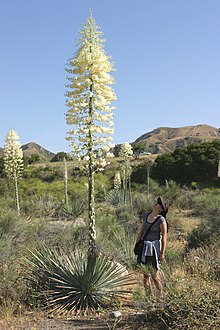Hesperoyucca whipplei
| Chaparral yucca | |
|---|---|
 |
|
| Scientific classification | |
| Kingdom: | Plantae |
| Clade: | Angiosperms |
| Clade: | Monocots |
| Order: | Asparagales |
| Family: | Asparagaceae |
| Subfamily: | Agavoideae |
| Genus: | Hesperoyucca |
| Species: | H. whipplei |
| Binomial name | |
|
Hesperoyucca whipplei (Torr.) Trel. |
|
Hesperoyucca whipplei (syn. Yucca whipplei ) (chaparral yucca,our Lord's candle,Spanish bayonet,Quixote yucca or foothill yucca is a species of flowering plant closely related to, and formerly usually included in, the genus Yucca. It is native to southern California, United States and Baja California, Mexico, where it occurs mainly in chaparral, coastal sage scrub, and oak woodland plant communities at altitudes of 0–2500 m.
It produces a stemless cluster of long, rigid leaves which end in a sharp point. The leaves are 20–90 cm (rarely to 125 cm) long and 0.7–2 cm wide, and gray-green in color. The leaf edges are finely saw-toothed.
The single inflorescence grows extremely fast, and reaches 0.9–3 m tall, bearing hundreds of elliptical (bell shaped) white to purplish flowers 3 cm diameter on a densely branched panicle up to 70 cm broad, covering the upper half of the inflorescence. The fruit is a dry winged capsule, which splits open at maturity to release the seeds.
The plant takes several (usually 5+) years to reach maturity and flower, at which point it usually dies. Most subspecies produce offshoots from the base, so that although the parent plant flowers and dies, a cluster of clones around its base continue to grow and reproduce. It may also grow back from its base after much of its foliage has been scorched off by the wildfires that frequent its range.
The taxonomy of Hesperoyucca whipplei is complex and controversial.Hesperoyucca was described as a genus by Georg Engelmann as long ago as 1892, but it has taken recent DNA analysis to confirm that they are genetically distinct from Yucca. The splitting of Hesperoyucca from Yucca is still not widely reflected in available literature or online (for example, the British Royal Botanic Gardens, Kew and the Royal Horticultural Society websites do not recognise the name as current).
...
Wikipedia
